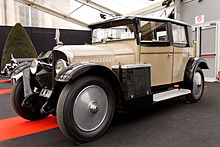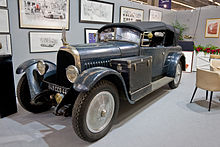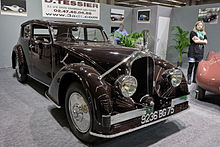Aéroplanes G. Voisin

The SA des Aéroplanes G. Voisin was a French company that manufactured automobiles and aircraft . The location was Issy-les-Moulineaux .
prehistory
Gabriel Voisin and Louis Blériot founded an aircraft manufacturing company in 1905. In 1906 the two partners separated.
Company history
First European plane
The separation from Blériot led in 1906 to the establishment of an own aircraft factory with Gabriel Voisin as designer and his brother Charles Voisin as pilot , the Societé des Aéroplanes Voisin . This initially dealt with the manufacture of glider planes , but these were soon motorized. In 1907 , the Voisin Standard was created with the construction of a machine for Léon Delagrange , which flew 60 meters on the first flight of Charles Voisin on March 30, 1907 . Another machine of this type was delivered to Henri Farman at the end of 1907 , who modified it into the Voisin-Farman I. The company became known in Europe when, in January 1908, Henri Farman succeeded in winning the Grand Prix d'Aviation, endowed with 50,000 francs, for a flight over the closed kilometer at the Issy-les-Moulineaux airfield . According to the contemporary reference work Jane's All the World's Aircraft (1913) by Fred T. Jane, the Voisin was the first European aircraft to fly really successfully.
Military aircraft
During the First World War , the company was an important manufacturer of military aircraft, in particular the Voisin III was produced. Gabriel Voisin - his brother was killed in a traffic accident in 1912 - was quite wealthy at the end of the war. After the end of the war, he turned away from aircraft construction and worked with his befriended automobile designer André Citroën to build a luxury car developed by Citroën engineers for the Voisin company.
Restriction to the automobile
In 1919, however, all other productions except for the luxury car named M1 were discontinued, as it proved to be extremely successful and profitable for Voisin.
The M1 was a six-seater vehicle with a wheelbase of approx. 3.50 meters, powered by a 4-liter valve engine with an output of 75 hp that was unrivaled in relation to the usual engines due to its design principle and also low-maintenance . However, the production costs for this vehicle were quite high due to the valve engine and the number of potential buyers was relatively low, and so smaller vehicles were soon presented, such as the C1 with 100 hp (up to 130 hp when used in racing vehicles) and the C3 in 1922 , an improved C1 with four-wheel brake.
A smaller version of the M1 with a 1.3 liter valve engine, called the C4 , was also produced. The C2 was an automobile with a wheelbase of approximately four meters, powered by a 7.2 liter V12 engine . However, only two copies of this car were made. There was also the C23 .
Voisin engines were occasionally used in vehicles from other manufacturers, including the front-wheel drive Bucciali TAV 12 from 1932.
race car
The company also produced cars for automobile racing . It even put together a full team of four vehicles for the French Grand Prix in 1923. Since the cars were far inferior in terms of performance to those of the competition, the bodies were designed to be extremely light and aerodynamic based on experience from aircraft construction.
The company took part in the most varied of racing classes with constantly modified "laboratories", and with a specially built vehicle - called the C5 - 50 different long-distance records were set.
Series vehicles
But Voisin also did not remain idle in the field of series vehicles and developed innovations such as B. bodies made of aluminum or improvement of the drag coefficient by tapering upward bodies.
From 1937 built-in engines from Graham-Paige were used. In 1939 automobile production was stopped. The plant was then taken over by Gnôme et Rhône , a French aircraft engine and motorcycle manufacturer . However, Voisin stayed with the company as director and designer.
After the war
In October 1950 the company presented a small car with front-wheel drive at the Paris Motor Show , and two years later one with a rear-engine. These models remained prototypes . The Spanish company Autonacional SA took over the project, developed it further and sold the vehicles as Biscúter .
literature
- Harald H. Linz, Halwart Schrader : The International Automobile Encyclopedia . United Soft Media Verlag, Munich 2008, ISBN 978-3-8032-9876-8 .
- George Nick Georgano (Editor-in-Chief): The Beaulieu Encyclopedia of the Automobile. Volume 3: P – Z. Fitzroy Dearborn Publishers, Chicago 2001, ISBN 1-57958-293-1 . (English)
Web links
- Automobiles Voisin (English and French, accessed December 18, 2013)
- Hargrave report on the Voisin brothers and their aircraft (accessed December 18, 2013)
- GTÜ Society for Technical Monitoring mbH (accessed on December 18, 2013)
Individual evidence
- ^ Nouveaux essais de l'aéroplane Delagrange . In: L'Aérophile . April 1907, ISSN 0994-8929 , p. 105 ( JPG file [accessed February 28, 2015]).
- ↑ Fred T. Jane (Ed.): Jane's All The World's Aircraft . Sampson Low Marston, 1913, ISBN 978-0-7153-4388-3 , pp. 12b ( online [accessed March 12, 2015]).
- ↑ a b c d Georgano: The Beaulieu Encyclopedia of the Automobile.
- ↑ a b Harald H. Linz, Halwart Schrader : The International Automobile Encyclopedia . United Soft Media Verlag, Munich 2008, ISBN 978-3-8032-9876-8 .








